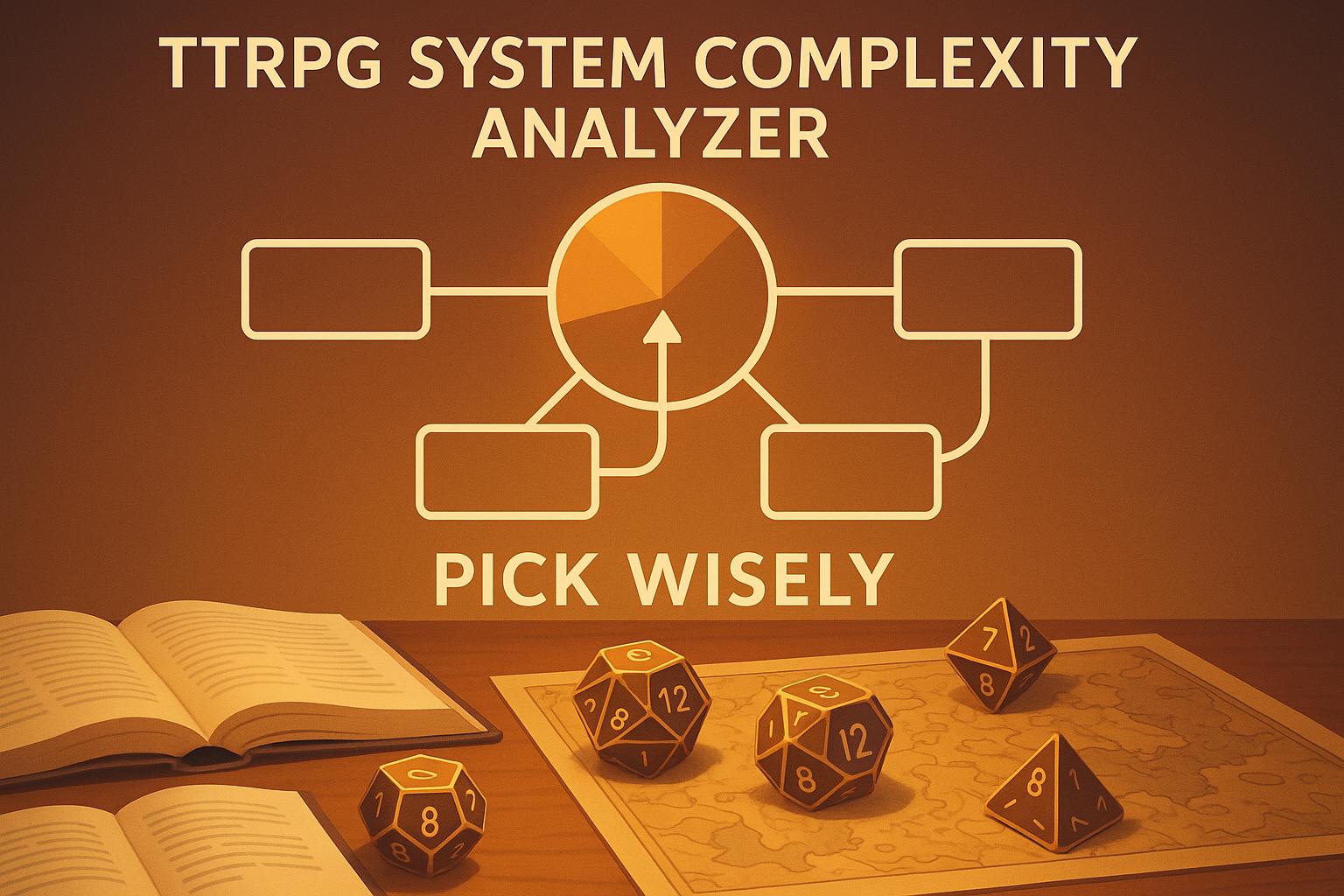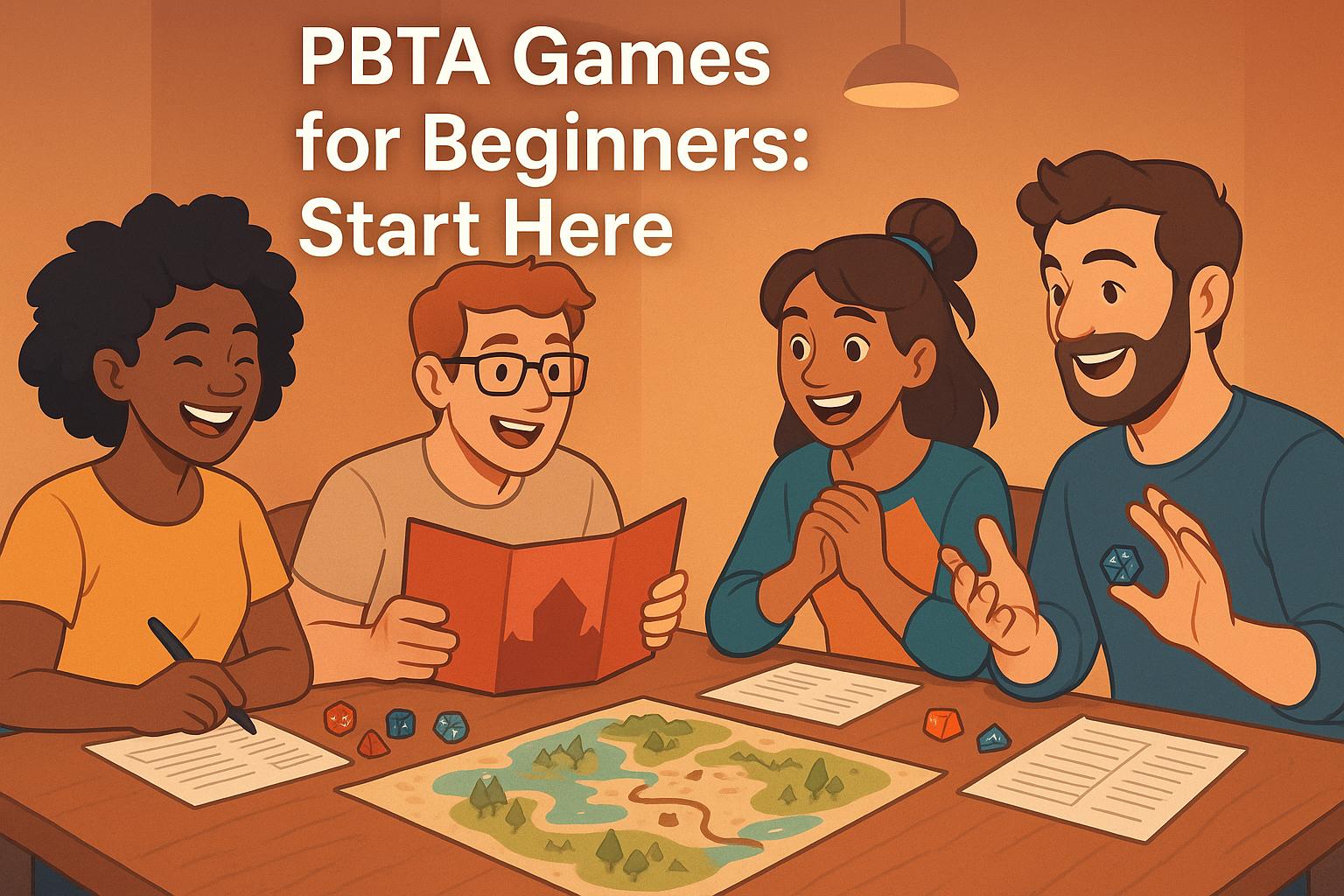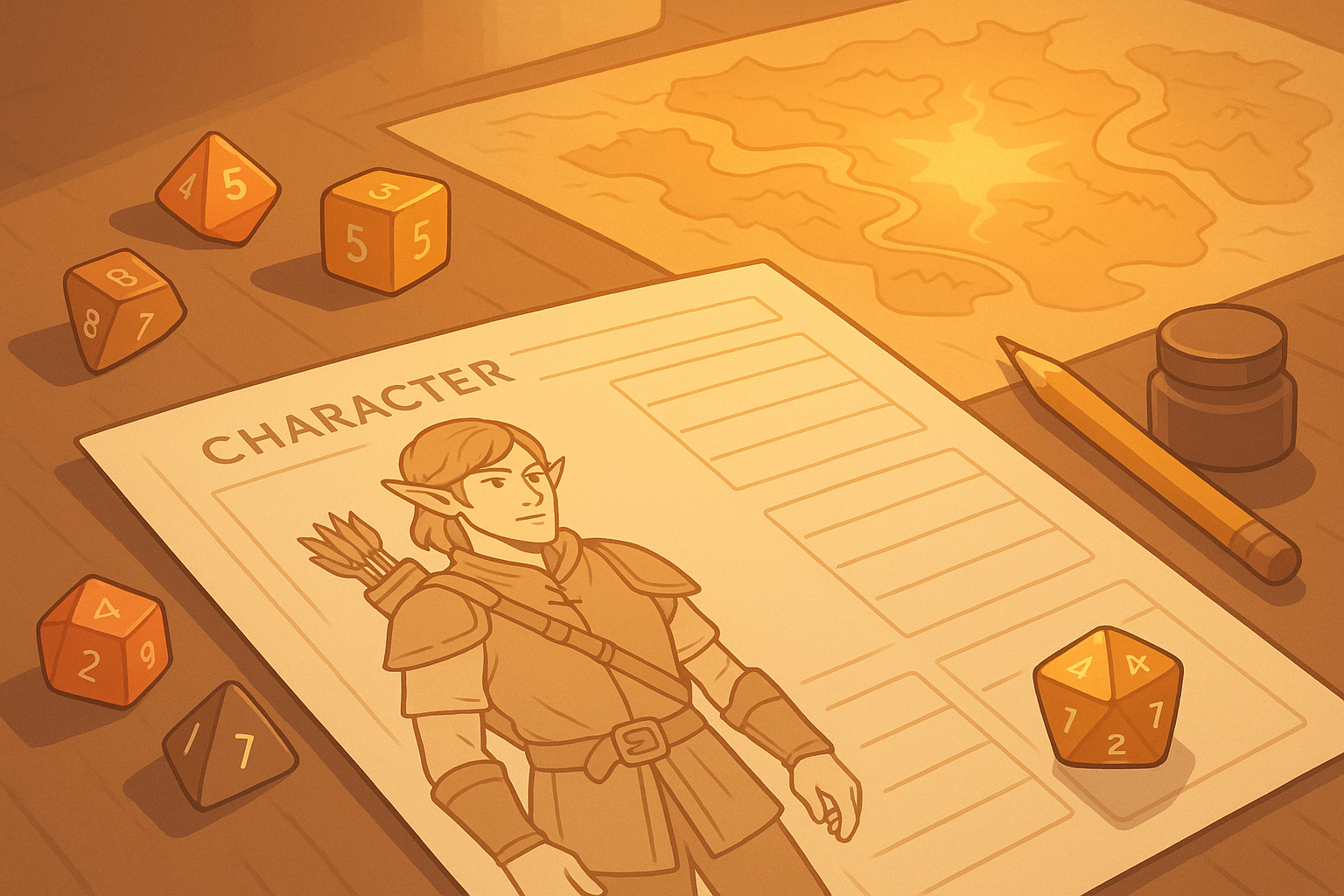PBTA (Powered by the Apocalypse) has reshaped tabletop role-playing games by prioritizing story over complex rules. Introduced in 2010 with Apocalypse World, PBTA games use simple mechanics like 2d6 rolls, character "moves", and thematic "playbooks" to create immersive, player-driven narratives. Over time, the system expanded into diverse genres, inspiring games like Dungeon World (fantasy), Monsterhearts (supernatural drama), and Brindlewood Bay (cozy mysteries with horror elements).
Key highlights:
- Core Mechanics: 2d6 rolls, fiction-first design, and player-focused storytelling.
- Playbooks: Act as templates for unique character roles and abilities.
- Genre Flexibility: PBTA games range from post-apocalyptic survival to superhero tales and mystery-solving.
- Player Agency: Encourages collaborative worldbuilding and emergent storytelling.
PBTA’s influence extends beyond its ecosystem, inspiring new RPGs to focus on narrative flow and simplicity. From gritty wastelands to quaint seaside towns, PBTA continues to redefine what tabletop gaming can be.
Powered by the Apocalypse: My favorite PbtA games and mechanics - Table Talk - Livestream #14
Core PBTA Mechanics and Design Principles
PBTA games are all about storytelling, and their mechanics are designed to make that storytelling smooth and engaging. By focusing on just a few core elements, PBTA games create an experience that's easy to learn while fostering the kind of collaborative narratives that make these games stand out.
Moves and Playbooks
Moves are the heart of PBTA mechanics, designed to fit naturally into the flow of the story. They activate when specific situations arise in the narrative, making the mechanics feel like an extension of the storytelling rather than a separate layer.
Take the "Go Aggro" move from Apocalypse World. It kicks in when you threaten someone with immediate violence unless they comply. You roll 2d6 and add your Hard stat. On a 10 or higher, they must either back down or force you to follow through on your threat. On a 7–9, they can still back down but get to make a demand of their own. This approach ensures that every roll feels tied to the drama of the moment.
Playbooks, on the other hand, act as character templates that guide not just what your character can do, but who they are in the story. Each playbook comes with its own set of moves, stats, and narrative focus. For instance, the Hardholder in Apocalypse World excels at leadership and managing resources, while the Brainer brings psychic abilities and a knack for manipulation. These aren't just mechanical differences - they're narrative roles that help each character contribute something distinct to the story.
One of the best things about playbooks is how they simplify character creation. Instead of wading through endless options, you pick a playbook that matches the kind of character you want to play, then customize it within that framework. For example, the Driver playbook immediately tells you you're playing someone whose life revolves around vehicles and mobility, but it still leaves room for you to shape their personality and backstory.
These mechanics set the stage for PBTA's straightforward yet effective resolution system.
2d6 Resolution and Fiction-First Design
The 2d6 system might look simple, but it's built to create drama. Rolls result in one of three outcomes: a 10 or higher is a full success, 7–9 is a partial success with complications, and 6 or less is a failure - but even failure pushes the story forward.
What makes this system shine is that failure isn't a dead end. Instead, it gives the Game Master a chance to introduce complications, reveal secrets, or escalate tension. For example, in Masks: A New Generation, failing to "Read a Situation" doesn’t just mean you miss out on clues. The GM might reveal that the situation is far more dangerous than it seemed, or that someone you trusted has been deceiving you.
PBTA games follow a fiction-first design philosophy. This means the story dictates when the dice come into play, not the other way around. You don’t roll to attack - you describe your character’s actions, and if they align with a move like "Go Aggro", then you roll. This keeps the focus on the narrative while ensuring the mechanics enhance the story.
Another key principle is "Say yes or roll dice." If a player’s action isn’t dramatically significant or doesn’t carry meaningful stakes, the GM simply allows it to happen. Dice rolls are reserved for moments that truly matter to the story.
Player-Focused Design
PBTA games shift much of the narrative power to the players, giving them a significant role in shaping the story. Many moves explicitly allow players to establish new details about the world or drive the plot forward.
The "Spout Lore" move in Dungeon World is a great example. When a player rolls successfully, they get to share something interesting and useful about the current situation, adding new elements to the game world.
Another hallmark of PBTA is its player-facing rolls. Instead of the GM rolling for an NPC’s actions, the players roll to respond. For instance, if a monster attacks, the player might roll to "Defy Danger" or protect themselves. This approach keeps players engaged and ensures they remain active participants in the story, even when reacting to threats.
PBTA also emphasizes the principle of "Ask questions and use the answers." When players describe their characters’ backstories or make assumptions about the world, savvy GMs weave those details into the narrative instead of overriding them.
Finally, PBTA games embrace the philosophy of "Play to find out what happens." Instead of following a rigid plot, the game unfolds organically, with everyone at the table - including the GM - discovering the story as it develops. This collaborative approach is central to PBTA’s design and has influenced countless other games in the genre.
Major PBTA Games and Their Development
The journey from Apocalypse World to Brindlewood Bay showcases how the PBTA framework can evolve and thrive across a variety of genres. Each major release has taken the core mechanics in unique directions, proving their versatility. Whether you're surviving in a post-apocalyptic wasteland, delving into a fantasy world, or solving cozy mysteries, these games highlight just how dynamic PBTA can be.
Apocalypse World: The Beginning
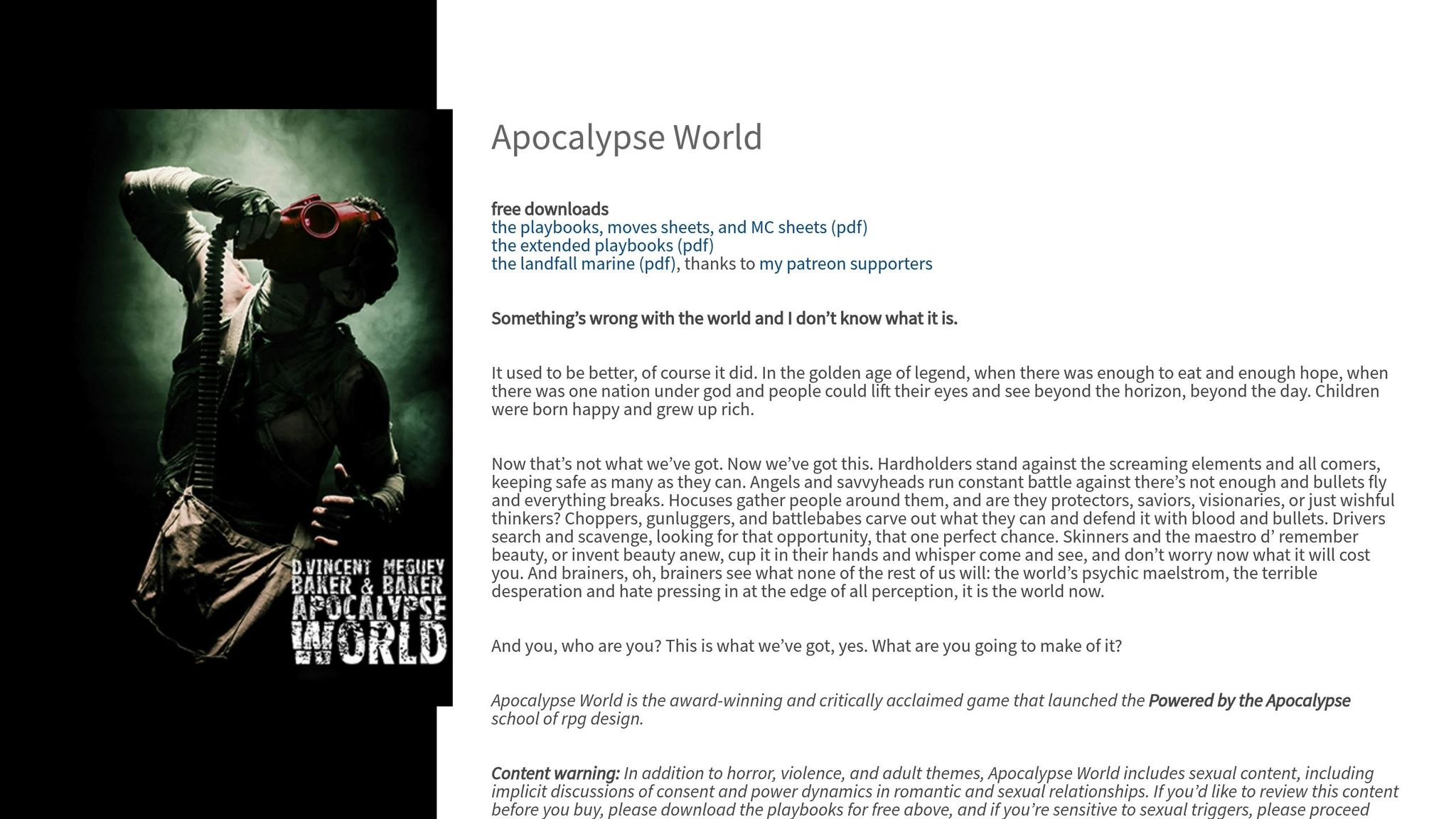
In 2010, Vincent Baker reshaped the RPG landscape with Apocalypse World. This game redefined role-playing by prioritizing narrative outcomes over intricate mechanics. By stripping away the traditional complexities of RPG systems, Baker created a system that put collaborative storytelling at the forefront.
The impact of Apocalypse World is hard to overstate. It introduced groundbreaking ideas like making failure an opportunity for compelling storytelling rather than a frustrating dead end. Players were encouraged to actively shape the world through their decisions and backstories. The playbooks, more than just character classes, acted as narrative archetypes, giving players a clear sense of their role in the unfolding drama. The game’s focus on human relationships in a crumbling society brought themes like power, trust, and survival to the forefront.
Genre Expansions: Dungeon World, Monsterhearts, and Masks
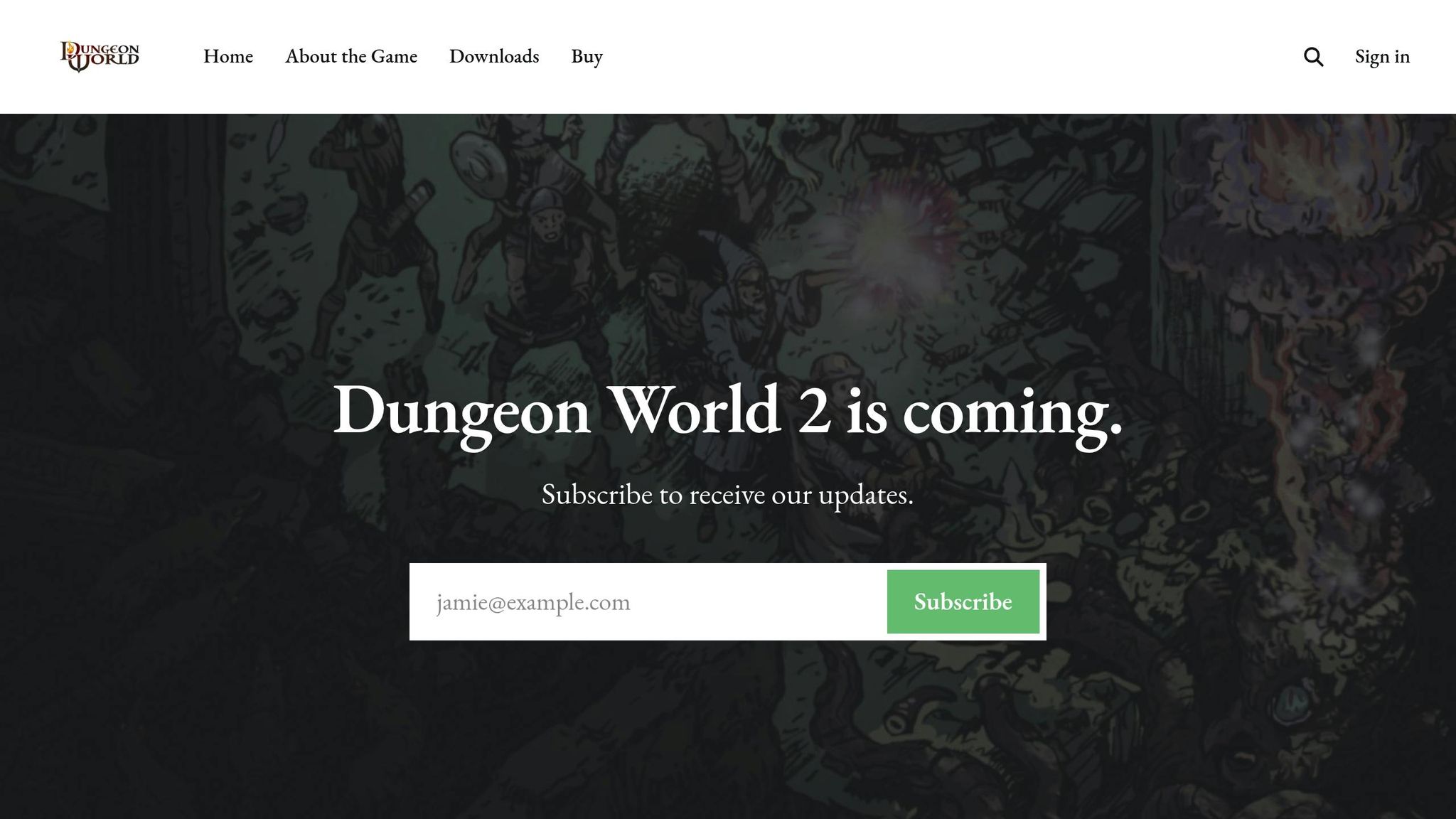
PBTA's adaptability became even more evident as designers reimagined its mechanics for different genres. Dungeon World, created by Sage LaTorra and Adam Koebel, brought traditional fantasy adventures into the PBTA fold. By combining classic fantasy archetypes with PBTA’s narrative-driven mechanics, it offered a fresh take on dungeon crawling.
Monsterhearts, designed by Avery Alder, shifted the focus to teenage supernatural drama. Inspired by shows like Buffy the Vampire Slayer and Teen Wolf, the game introduced mechanics like Strings, which represent emotional leverage, to capture the messy, complex dynamics of adolescence and identity.
Masks: A New Generation, by Brendan Conway, turned PBTA’s storytelling tools toward superhero tales, specifically focusing on young heroes. Instead of traditional stats, Masks uses Labels to reflect how characters see themselves and how others perceive them. This ties a character’s abilities directly to their emotional state and sense of identity, making every action feel deeply personal. These adaptations laid the groundwork for the next leap in PBTA design, seen in Brindlewood Bay.
Brindlewood Bay: Cozy Mystery Mechanics
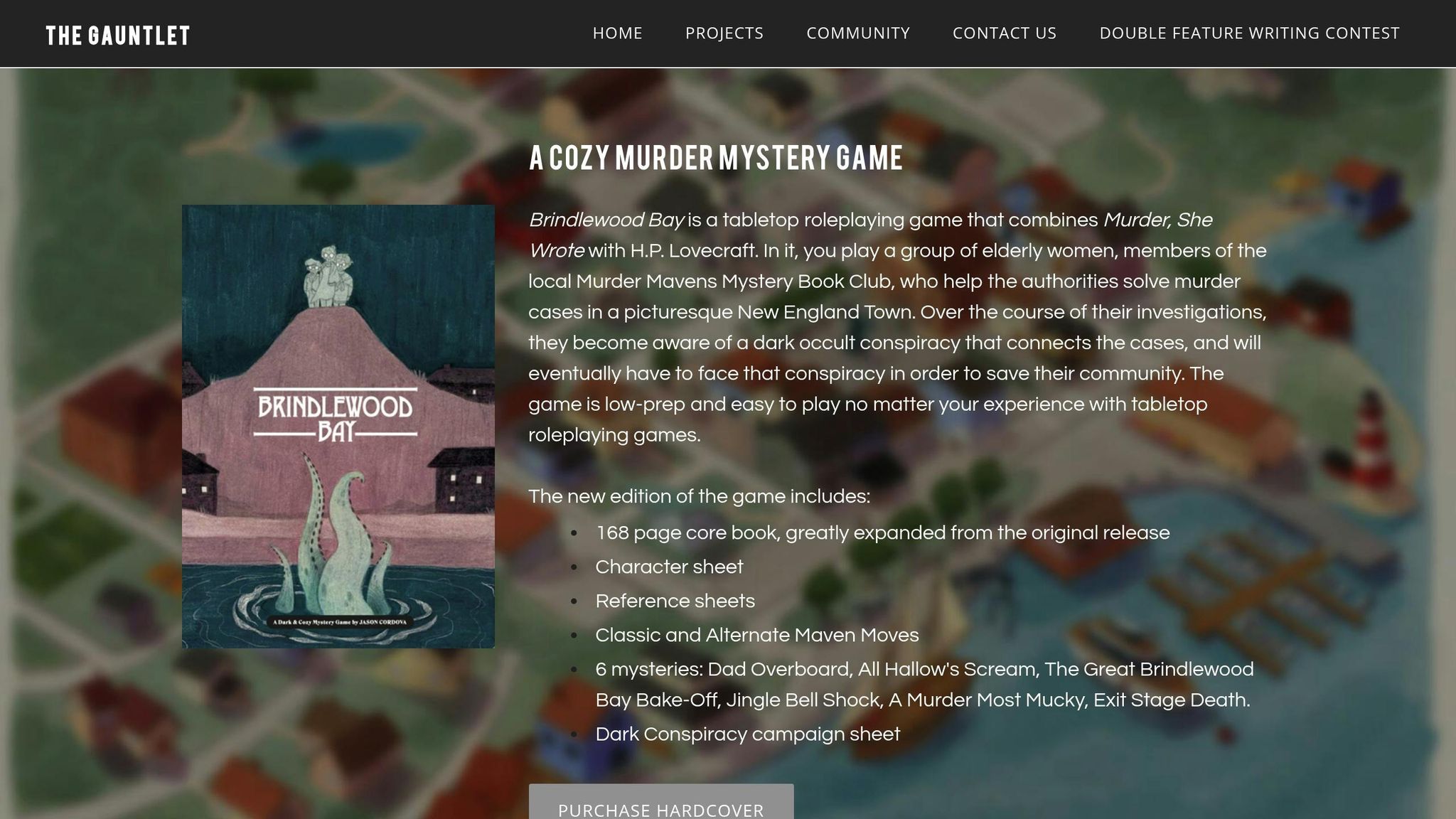
Jason Cordova’s Brindlewood Bay represents one of the most inventive adaptations of PBTA. Blending the cozy mystery genre - think Murder, She Wrote - with subtle Lovecraftian horror, the game creates a unique narrative experience.
Its 2021 Kickstarter campaign was a huge success, raising $477,517 from 7,748 backers on a $10,000 goal. This success highlights how PBTA continues to evolve, merging its narrative-first roots with fresh storytelling approaches. In Brindlewood Bay, the mystery-solving process stays true to PBTA principles. Instead of the GM deciding the culprit beforehand, the solution emerges organically from the players’ investigations and theories. The game’s elderly sleuths uncover clues in their quaint New England town, and the mechanics determine whether their theories hold up.
The 168-page core book, which expanded from its original zine format, delivers a complete cozy mystery system. With investigation-specific moves like "Research", "Theorize", and "Solve the Mystery", the game emphasizes collaboration and emergent storytelling. Brindlewood Bay has also inspired a wave of "Carved From Brindlewood" hacks, showing how its innovative mystery mechanics can be adapted to other genres.
These games collectively demonstrate that PBTA mechanics are not just versatile - they are a foundation for storytelling that thrives in any genre, always keeping collaboration and narrative at the heart of the experience.
PBTA Games Across Different Genres
One of the standout qualities of PBTA (Powered by the Apocalypse) games is how easily they adapt to different genres. While it all began with the gritty, post-apocalyptic world of Apocalypse World, the system has since expanded to include everything from cozy mysteries to supernatural dramas. Each adaptation stays true to PBTA's core principles but introduces tailored mechanics to fit its unique narrative style.
The experience of playing PBTA games varies widely depending on the genre. For instance, the intense, chaotic energy of Apocalypse World feels worlds apart from the cooperative, mystery-driven storytelling of Brindlewood Bay. This flexibility has established PBTA as a major influence in the world of modern tabletop role-playing games. The table below highlights how PBTA games evolve across different genres, showcasing their unique mechanics and storytelling approaches.
Game Comparison Table
| Game | Genre/Theme | Tone & Style | Key Mechanical Innovation | Narrative Focus | GM Structure |
|---|---|---|---|---|---|
| Apocalypse World | Post-apocalyptic | Gritty, visceral, fast-paced, rebellious | Original 2d6 system and playbooks | Complex human relationships | Traditional GM with narrative authority |
| Dungeon World | Fantasy adventure | Classic, heroic, D&D-inspired | Bonds system and class-based playbooks | Heroic quests and exploration | GM guides dungeon-crawling adventures |
| Monsterhearts | Teenage supernatural drama | Emotional, messy, identity-driven | Strings (emotional leverage) | Coming-of-age and self-discovery | GM focuses on relationship dynamics |
| Masks | Young superhero stories | Hopeful, identity-focused | Labels instead of stats, team mechanics | Personal growth and heroic identity | GM balances action and character arcs |
| Brindlewood Bay | Cozy mystery with horror | Collaborative, investigative | Mystery-solving through theory mechanics | Community-driven problem-solving | GM facilitates emergent mystery storytelling |
| Monster of the Week | Modern monster hunting | Episodic, action-packed, TV-inspired | Luck mechanic, mystery countdown | Weekly monster investigations | GM structures episodic adventures |
PBTA's ability to adapt its mechanics to fit different genres is evident in games like Dungeon World, Monsterhearts, and Masks. While the mechanics remain rooted in PBTA's narrative-first approach, they are cleverly adjusted to bring each game's theme to life. For example, Apocalypse World thrives on its raw, post-apocalyptic chaos, while Brindlewood Bay emphasizes collaborative mystery-solving with a cozy yet eerie tone.
Even the role of the Game Master (GM) shifts depending on the game. In Apocalypse World, the GM holds traditional narrative authority, while in Brindlewood Bay, the GM's role is more focused on facilitating the players' collaborative storytelling. These variations underline PBTA's flexibility, allowing it to cater to a wide range of gaming styles and preferences.
This genre-crossing adaptability has not only expanded PBTA's influence but also opened the door to endless creative possibilities for players and designers alike. Whether you're drawn to post-apocalyptic survival, teenage drama, or solving mysteries in a quaint seaside town, PBTA offers something to spark inspiration for your next campaign.
sbb-itb-b8b00a5
PBTA's Impact on Modern Tabletop RPG Design
Powered by the Apocalypse (PBTA) has left a lasting mark on tabletop RPG design. Since Apocalypse World made its debut in 2010, PBTA has shifted the focus of RPGs toward narrative flow and player-driven storytelling, creating a collaborative, character-focused gaming experience.
PBTA's Influence on Indie RPGs
The indie RPG scene quickly embraced PBTA's approach to storytelling, moving away from the rigid mechanics that once defined many games. Before Apocalypse World, indie RPGs often relied on complex systems that prioritized numbers over narrative. PBTA flipped the script, showing that streamlined, story-centered rules could be just as engaging. This change encouraged designers to focus on what characters do within the story, rather than bogging gameplay down with intricate numerical systems. The result? A wave of games where players take an active role in crafting the narrative, rather than simply reacting to it.
PBTA Mechanics in Other RPG Systems
PBTA's innovative mechanics have influenced countless games, even those that don’t officially identify as PBTA. Many systems have adopted the concept of "moves" to resolve narrative actions. Some have embraced a fiction-first approach, similar to PBTA, while others have replaced traditional character classes with archetypal playbooks that immediately establish a character's role in the story.
The use of the 2d6 dice system, with its bell curve of outcomes, is another hallmark of PBTA. This mechanic creates nuanced results that often lead to unexpected narrative twists. Beyond the mechanics, PBTA's principles for game masters - such as prioritizing character-driven stories, encouraging player input, and letting the narrative dictate outcomes - have reshaped how many GMs approach their role, even in systems outside the PBTA framework.
Finding PBTA Games Through TTRPG Games Directory
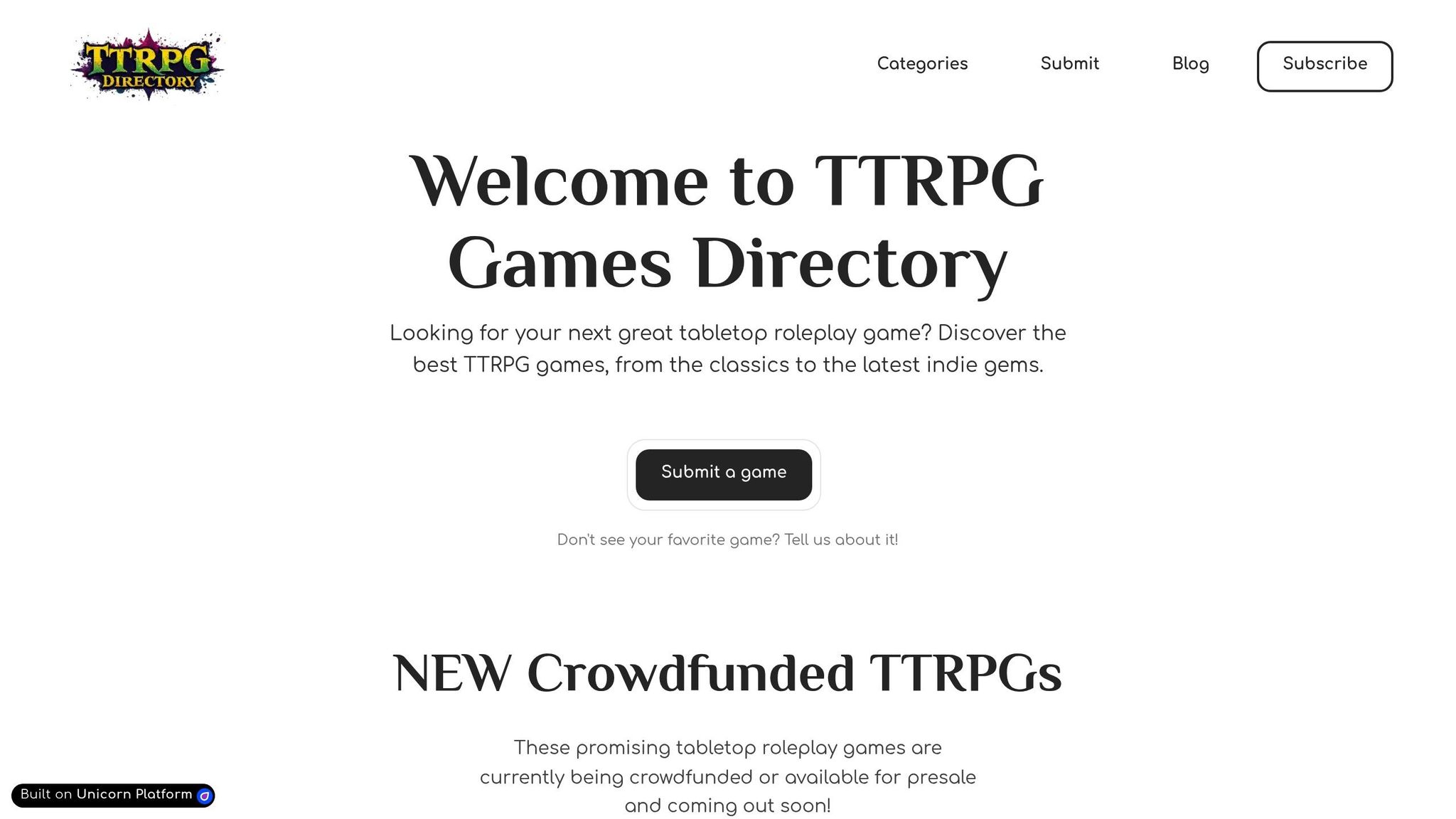
PBTA’s influence has also led to a growing variety of games built on its foundation. For players, this abundance can make it tricky to discover new titles. That’s where the TTRPG Games Directory comes in. This resource lists PBTA games across a range of genres, from the original Apocalypse World to inventive titles like Brindlewood Bay. Each listing explains how a game adapts PBTA’s mechanics to fit its theme, whether it’s supernatural drama, cozy mysteries, or post-apocalyptic survival.
The directory is also a helpful guide for newcomers, breaking down what sets PBTA games apart from traditional RPGs. It highlights each game’s unique approach, such as how Masks differs from Monsterhearts, or how Brindlewood Bay builds on the core ideas of Apocalypse World. By showcasing both classic and indie titles, the TTRPG Games Directory offers a one-stop resource for players eager to dive into the evolving world of PBTA-inspired games.
Conclusion: The Future of PBTA
The journey from Apocalypse World to Brindlewood Bay highlights how far PBTA's design has come. What started as Vincent Baker's gritty, post-apocalyptic RPG has grown into a framework that spans genres ranging from superhero epics to cozy mysteries. The real magic of PBTA lies not in its mechanics, but in its story-driven approach that puts narrative front and center.
This shift reflects a change in design philosophy. PBTA's focus on fiction-first, player-driven gameplay has reshaped how RPGs are crafted, prioritizing storytelling over complex simulations. Its signature 2d6 system, paired with moves that emerge directly from the narrative, demonstrates how simplicity can deliver powerful results.
Another key to PBTA's success is its vibrant, ever-evolving community. Each new game builds on the foundation, introducing fresh ideas. For example, Brindlewood Bay brought innovative mechanics for investigation and deduction, proving how adaptable the PBTA framework can be.
PBTA’s influence extends well beyond its own ecosystem. Many modern RPGs have adopted hallmark features introduced by Apocalypse World, like unique playbooks and narrative-focused moves. This widespread adoption underscores how PBTA's core principles - player agency and fluid storytelling - have become cornerstones of contemporary game design.
As tabletop RPGs grow more diverse and inclusive, PBTA’s focus on engaging narratives and accessibility positions it perfectly for continued success. Its streamlined mechanics allow new designers to concentrate on creating distinctive games without reinventing the wheel. This ease of use ensures PBTA will remain a catalyst for fresh ideas and bold experimentation in the RPG world.
The evolution from Apocalypse World to Brindlewood Bay and beyond represents more than mechanical tweaks - it embodies a paradigm shift toward collaborative storytelling. This shift has redefined tabletop gaming, and PBTA’s influence will undoubtedly continue to shape the future of RPGs for years to come.
FAQs
What makes PBTA games more focused on storytelling than traditional RPGs?
What Makes PBTA Games Unique?
PBTA games put storytelling front and center. Instead of relying on strict rules or pre-set storylines, these games thrive on open-ended narratives that evolve through player choices and teamwork. The Game Master (GM) plays a key role by building on player actions, asking thought-provoking questions, and weaving in unexpected twists to keep the story dynamic and immersive.
Unlike many traditional RPGs that focus heavily on intricate mechanics or detailed systems, PBTA games shift the focus to player-driven storytelling and character growth. This setup encourages creativity, spontaneity, and collaboration, ensuring every session feels fresh and one-of-a-kind.
What makes PBTA playbooks different from traditional character classes in other RPGs?
PBTA playbooks are unique because they prioritize storytelling and character growth over simply listing abilities or skills. Each playbook embodies a distinct archetype or narrative role, shaping not only what your character can do but also who they are and how their story develops. This design fosters gameplay that's rich in storytelling and evolves alongside the character's journey.
Unlike traditional RPG character classes, which often revolve around combat roles or mechanical upgrades, PBTA playbooks focus on themes, relationships, and personal development. This makes them a perfect fit for players who thrive on collaborative storytelling and enjoy crafting memorable, character-driven narratives.
How does Brindlewood Bay build on PBTA mechanics to combine cozy mysteries with horror?
Brindlewood Bay: A Fresh Take on PBTA
Brindlewood Bay builds on the Powered by the Apocalypse (PBTA) system, adding mechanics that mix cozy mystery vibes with a touch of creeping horror. One of its standout features is the Day and Night Moves. During the day, gameplay leans into cheerful sleuthing and lighthearted investigation. But as night falls, the tone shifts, bringing in darker, more suspenseful elements. This duality keeps the story dynamic and unpredictable.
Another key element is its clue-based mystery system. Instead of rigidly defined solutions, players work together to piece together clues and create their own answers to the mysteries they face. This blend of cozy mystery charm and cosmic horror unease makes for a truly engaging experience. It’s a great example of how PBTA’s framework can be shaped to deliver something fresh and genre-bending.
